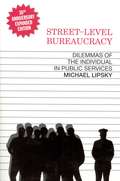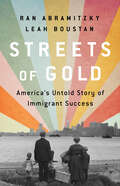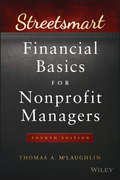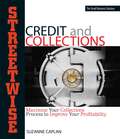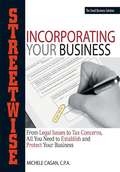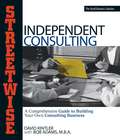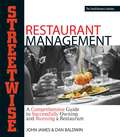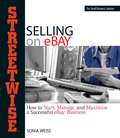- Table View
- List View
Street-Level Bureaucracy: Dilemmas of the Individual in Public Service
by Michael LipskyFirst published in 1980, Street-Level Bureaucracy received critical acclaim for its insightful study of how public service workers, in effect, function as policy decision makers, as they wield their considerable discretion in the day-to-day implementation of public programs. Three decades later, the need to bolster the availability and effectiveness of healthcare, social services, education, and law enforcement is as urgent as ever. In this thirtieth anniversary expanded edition, Michael Lipsky revisits the territory he mapped out in the first edition to reflect on significant policy developments over the last several decades. Despite the difficulties of managing these front-line workers, he shows how street-level bureaucracies can be and regularly are brought into line with public purposes. <p><p> Street-level bureaucrats—from teachers and police officers to social workers and legal-aid lawyers—interact directly with the public and so represent the frontlines of government policy. In Street-Level Bureaucracy, Lipsky argues that these relatively low-level public service employees labor under huge caseloads, ambiguous agency goals, and inadequate resources. When combined with substantial discretionary authority and the requirement to interpret policy on a case-by-case basis, the difference between government policy in theory and policy in practice can be substantial and troubling. <p> The core dilemma of street-level bureaucrats is that they are supposed to help people or make decisions about them on the basis of individual cases, yet the structure of their jobs makes this impossible. Instead, they are forced to adopt practices such as rationing resources, screening applicants for qualities their organizations favor, “rubberstamping” applications, and routinizing client interactions by imposing the uniformities of mass processing on situations requiring human responsiveness. Occasionally, such strategies work out in favor of the client. But the cumulative effect of street-level decisions made on the basis of routines and simplifications about clients can reroute the intended direction of policy, undermining citizens’ expectations of evenhanded treatment. <p> This seminal, award-winning study tells a cautionary tale of how decisions made by overburdened workers translate into ad-hoc policy adaptations that impact peoples’ lives and life opportunities. Lipsky maintains, however, that these problems are not insurmountable. Over the years, public managers have developed ways to bring street-level performance more in line with agency goals. This expanded edition of Street-Level Bureaucracy underscores that, despite its challenging nature, street-level work can be made to conform to higher expectations of public service.
Streetfight
by Seth Solomonow Janette Sadik-KhanAn empowering road map for rethinking, reinvigorating, and redesigning our cities, from a pioneer in the movement for safer, more livable streetsAs New York City's transportation commissioner, Janette Sadik-Khan managed the seemingly impossible and transformed the streets of one of the world's greatest, toughest cities into dynamic spaces safe for pedestrians and bikers. Her approach was dramatic and effective: Simply painting a part of the street to make it into a plaza or bus lane not only made the street safer, but it also lessened congestion and increased foot traffic, which improved the bottom line of businesses. Real-life experience confirmed that if you know how to read the street, you can make it function better by not totally reconstructing it but by reallocating the space that's already there. Breaking the street into its component parts, Streetfight demonstrates, with step-by-step visuals, how to rewrite the underlying "source code" of a street, with pointers on how to add protected bike paths, improve crosswalk space, and provide visual cues to reduce speeding. Achieving such a radical overhaul wasn't easy, and Streetfight pulls back the curtain on the battles Sadik-Khan won to make her approach work. She includes examples of how this new way to read the streets has already made its way around the world, from pocket parks in Mexico City and Los Angeles to more pedestrian-friendly streets in Auckland and Buenos Aires, and innovative bike-lane designs and plazas in Austin, Indianapolis, and San Francisco. Many are inspired by the changes taking place in New York City and are based on the same techniques. Streetfight deconstructs, reassembles, and reinvents the street, inviting readers to see it in ways they never imagined.From the Hardcover edition.
Streetfight: Handbook for an Urban Revolution
by Seth Solomonow Janette Sadik-KhanLike a modern-day Jane Jacobs, Janette Sadik-Khan transformed New York City's streets to make room for pedestrians, bikers, buses, and green spaces. Describing the battles she fought to enact change, Streetfight imparts wisdom and practical advice that other cities can follow to make their own streets safer and more vibrant. As New York City’s transportation commissioner, Janette Sadik-Khan managed the seemingly impossible and transformed the streets of one of the world’s greatest, toughest cities into dynamic spaces safe for pedestrians and bikers. Her approach was dramatic and effective: Simply painting a part of the street to make it into a plaza or bus lane not only made the street safer, but it also lessened congestion and increased foot traffic, which improved the bottom line of businesses. Real-life experience confirmed that if you know how to read the street, you can make it function better by not totally reconstructing it but by reallocating the space that’s already there. Breaking the street into its component parts, Streetfight demonstrates, with step-by-step visuals, how to rewrite the underlying “source code” of a street, with pointers on how to add protected bike paths, improve crosswalk space, and provide visual cues to reduce speeding. Achieving such a radical overhaul wasn’t easy, and Streetfight pulls back the curtain on the battles Sadik-Khan won to make her approach work. She includes examples of how this new way to read the streets has already made its way around the world, from pocket parks in Mexico City and Los Angeles to more pedestrian-friendly streets in Auckland and Buenos Aires, and innovative bike-lane designs and plazas in Austin, Indianapolis, and San Francisco. Many are inspired by the changes taking place in New York City and are based on the same techniques. Streetfight deconstructs, reassembles, and reinvents the street, inviting readers to see it in ways they never imagined.From the Trade Paperback edition.
Streetlights and Shadows: Searching for the Keys to Adaptive Decision Making
by Gary A. KleinAn expert explains how the conventional wisdom about decision making can get us into trouble—and why experience can't be replaced by rules, procedures, or analytical methods.In making decisions, when should we go with our gut and when should we try to analyze every option? When should we use our intuition and when should we rely on logic and statistics? Most of us would probably agree that for important decisions, we should follow certain guidelines—gather as much information as possible, compare the options, pin down the goals before getting started. But in practice we make some of our best decisions by adapting to circumstances rather than blindly following procedures. In Streetlights and Shadows, Gary Klein debunks the conventional wisdom about how to make decisions. He takes ten commonly accepted claims about decision making and shows that they are better suited for the laboratory than for life. The standard advice works well when everything is clear, but the tough decisions involve shadowy conditions of complexity and ambiguity. Gathering masses of information, for example, works if the information is accurate and complete—but that doesn't often happen in the real world. (Think about the careful risk calculations that led to the downfall of the Wall Street investment houses.) Klein offers more realistic ideas about how to make decisions in real-life settings. He provides many examples—ranging from airline pilots and weather forecasters to sports announcers and Captain Jack Aubrey in Patrick O'Brian's Master and Commander novels—to make his point. All these decision makers saw things that others didn't. They used their expertise to pick up cues and to discern patterns and trends. We can make better decisions, Klein tells us, if we are prepared for complexity and ambiguity and if we will stop expecting the data to tell us everything.
Streets and the Shaping of Towns and Cities
by Michael Southworth Eran Ben-JosephThe topic of streets and street design is of compelling interest today as public officials, developers, and community activists seek to reshape urban patterns to achieve more sustainable forms of growth and development. Streets and the Shaping of Towns and Cities traces ideas about street design and layout back to the early industrial era in London suburbs and then on through their institutionalization in housing and transportation planning in the United States. It critiques the situation we are in and suggests some ways out that are less rigidly controlled, more flexible, and responsive to local conditions. Originally published in 1997, this edition includes a new introduction that addresses topics of current interest including revised standards from the Institute of Transportation Engineers; changes in city plans and development standards following New Urbanist, Smart Growth, and sustainability principles; traffic calming; and ecologically oriented street design. "
Streets of Gold: America's Untold Story of Immigrant Success
by Ran Abramitzky Leah BoustanForbes, Best Business Books of 2022 Behavioral Scientist, Notable Books of 2022The facts, not the fiction, of America&’s immigration experience Immigration is one of the most fraught, and possibly most misunderstood, topics in American social discourse—yet, in most cases, the things we believe about immigration are based largely on myth, not facts. Using the tools of modern data analysis and ten years of pioneering research, new evidence is provided about the past and present of the American Dream, debunking myths fostered by political opportunism and sentimentalized in family histories, and draw counterintuitive conclusions, including: Upward Mobility: Children of immigrants from nearly every country, especially those of poor immigrants, do better economically than children of U.S.-born residents – a pattern that has held for more than a century. Rapid Assimilation: Immigrants accused of lack of assimilation (such as Mexicans today and the Irish in the past) actually assimilate fastest. Improved Economy: Immigration changes the economy in unexpected positive ways and staves off the economic decline that is the consequence of an aging population. Helps U.S. Born: Closing the door to immigrants harms the economic prospects of the U.S.-born—the people politicians are trying to protect. Using powerful story-telling and unprecedented research employing big data and algorithms, Abramitzky and Boustan are like dedicated family genealogists but millions of times over. They provide a new take on American history with surprising results, especially how comparable the &“golden era&” of immigration is to today, and why many current policy proposals are so misguided.
Streetsmart Financial Basics for Nonprofit Managers
by Thomas A. MclaughlinPraise for Streetsmart Financial Basics for Nonprofit Managers, Third Edition"Tom McLaughlin is a proven master at making the daunting concepts of nonprofit financial management clear and engaging. This book is a superb introduction for new nonprofit executives, board members, and students. It is also an excellent refresher and reference for those of us who have been around the nonprofit sector for a while. It is well written, concise, and thought provoking."--J. Gregory Dees, Professor of the Practice of Social Entrepreneurship and Nonprofit Management at Duke University's Fuqua School of Business, and coauthor of Enterprising Nonprofits and Strategic Tools for Social Entrepreneurs"A very practical guide to understanding and managing the finances of a nonprofit organization. As nonprofits strive for greater accountability, Tom McLaughlin's real-world examples and accessible style make this book indispensable for nonprofit executives, managers, and board members at organizations of any size."--Gordon J. Campbell, President and CEO, United Way of New York City"Tom McLaughlin's powerful book is far more than a useful tool. It provides the philosophical approach to instill strong stewardship and future viability to those in the world of nonprofits. He takes apart the complex issues of nonprofit stewardship just as Einstein translated relativity into a simple equation. Purely masterful."--Jim Mellor, Senior VP, Chief Financial Officer, YMCA of the USANote: CD-ROM/DVD and other supplementary materials are not included as part of eBook file.
Streetwise Business Plans
by Michele CaganNearly half of all new businesses fail within the first two years. To beat these odds, your new business needs a plan. Streetwise Business Plans shows you how to create a professional business plan in no time flat. This book explains how to use a business plan to establish a sound business, develop a complete marketing strategy, and forecast change. This updated edition of a long-standing successful title provides multiple samples of prewritten text for every part of your plan and includes two complete sample business plans. Whether you're expanding an established enterprise or opening a one-person shop, the best way to get your new business off to a good start is with Streetwise Business Plans! The e-book version of this title does not include a CD.
Streetwise Business Plans: Create a Business Plan to Supercharge Your Profits!
by Michele CaganEvery great business begins with a great business plan!Nearly half of all new businesses fail within the first to years. To beat these odds, your new business needs a plan. Streetwise Business Plans with CD shows you how to create a professional business plan in no time. This book explains how to use a business plan to establish a sound business, develop a complete marketing strategy, and forecast change.Streetwise Business Plans with CD features multiple samples of prewritten text for every part of your plan, as well as two complete sample business plans.Streetwise Business Plans with CD includes sample material to be used in creating the ultimate business plan. The CD walks you through all of the basics and includes important topics such as Your General Executive Summary, Company Summary, Services & Products Summary, Market Analysis, Strategic Summary, Management Summary, and a Financial Plan.Whether you're expanding an established enterprise or opening a one-person shop, the best way to get your new business off to a good start is with Streetwise Business Plan with CD!
Streetwise Credit And Collections
by Suzanne CaplanThe credit and collection function of any business is the nerve center of the Company. If proper records aren't kept and receivables closely monitored, a Company will have difficulty maintaining its cash flow and Operations. Streetwise[Registered] Credit and Collections provides you with the skills to manage your company's financial obligations, collect due payments, and avoid falling into debt.
Streetwise Credit And Collections
by Suzanne CaplanThe credit and collection function of any business is the nerve center of the company. If proper records aren't kept and receivables closely monitored, a company will have difficulty maintaining its cash flow and operations. Streetwise Credit and Collections provides you with the skills to manage your company's financial obligations, collect due payments, and avoid falling into debt.Streetwise Credit and Collections includes complete state-by-state requirements for small claims court, and sections on the applicable laws, statute of limitations, and legal interest rates that may be charged. The appendices contain information necessary for all businesses that grant credit, including the Equal Credit Opportunity Act and the Fair Debt Collection Practices act.Includes advice on:Securing credit and granting itSetting credit policies for your customersHiring a collections agency as necessaryYou will undoubtedly encounter credit and collection issues from time to time. With Streetwise Credit and Collections, you'll have the information and advice to make the best business decisions and keep your cash flow healthy.
Streetwise Credit And Collections: Maximize Your Collections Process to Improve Your Profitability
by Suzanne CaplanThe credit and collection function of any business is the nerve center of the company. If proper records aren't kept and receivables closely monitored, a company will have difficulty maintaining its cash flow and operations. Streetwise Credit and Collections provides you with the skills to manage your company's financial obligations, collect due payments, and avoid falling into debt.Streetwise Credit and Collections includes complete state-by-state requirements for small claims court, and sections on the applicable laws, statute of limitations, and legal interest rates that may be charged. The appendices contain information necessary for all businesses that grant credit, including the Equal Credit Opportunity Act and the Fair Debt Collection Practices act.Includes advice on:Securing credit and granting itSetting credit policies for your customersHiring a collections agency as necessaryYou will undoubtedly encounter credit and collection issues from time to time. With Streetwise Credit and Collections, you'll have the information and advice to make the best business decisions and keep your cash flow healthy.
Streetwise Incorporating Your Business
by Michele CaganIncorporating your business can provide numerous legal and financial advantages - it also has long-term ramifications on how you manage and structure your organization. Streetwise Incorporating Your Business will not only educate you about the benefits of incorporating your business, but will also help you determine which corporate form and structure will be the most advantageous for your personal circumstances.You will learn the details of many critical business issues, including:Whether an S corporation or a C corporation is better for your organizationWhich state and federal regulations will affect your corporationHow to avoid hidden costs associated with incorporating your businessTax planning strategies and required accounting practicesStreetwise Incorporating Your Business will lead you through each decision, from choosing the best location to incorporate, deciding which information to include in official government filings, and learning how to organize board and shareholders meetings.
Streetwise Incorporating Your Business: From Legal Issues to Tax Concerns, All You Need to Establish and Protect Your Business
by Michele CaganIncorporating your business can provide numerous legal and financial advantages - it also has long-term ramifications on how you manage and structure your organization. Streetwise Incorporating Your Business will not only educate you about the benefits of incorporating your business, but will also help you determine which corporate form and structure will be the most advantageous for your personal circumstances.You will learn the details of many critical business issues, including:Whether an S corporation or a C corporation is better for your organizationWhich state and federal regulations will affect your corporationHow to avoid hidden costs associated with incorporating your businessTax planning strategies and required accounting practicesStreetwise Incorporating Your Business will lead you through each decision, from choosing the best location to incorporate, deciding which information to include in official government filings, and learning how to organize board and shareholders meetings.
Streetwise Independent Consulting
by Bob Adams David KintlerThe authoritative guide to building an independent consulting practice! Streetwise Independent Consulting is your one-stop resource for starting, running, and growing a consulting business. From finding new prospects, to writing proposals, to setting your pricing, this book has it all.
Streetwise Independent Consulting: Your Comprehensive Guide to Building Your Own Consulting Business
by David KintlerA Simon & Schuster eBook. Simon & Schuster has a great book for every reader.
Streetwise Landlording & Property Management
by Dan Baldwin Mark B. WeissAs appealing and lucrative as property ownership can be, it isn't an occupation to be learned through trial and error. It's essential property owners understand all the ins and outs--legally and financially--for their own welfare as well as their tenants. Streetwise Landlording and Property Management addresses all aspects of the business, from the practical to the strategic. Property management is a 24/7 job with high risks as well as rewards. Streetwise Landlording and Property Management helps you assess whether or not you're cut out for the job.
Streetwise Landlording & Property Management: Insider's Advice on How to Own Real Estate and Manage It Profitably
by Dan Baldwin Mark B WeissAs appealing and lucrative as property ownership can be, it isn't an occupation to be learned through trial and error. It's essential property owners understand all the ins and outs--legally and financially--for their own welfare as well as their tenants. Streetwise Landlording and Property Management addresses all aspects of the business, from the practical to the strategic. Property management is a 24/7 job with high risks as well as rewards. Streetwise Landlording and Property Management helps you assess whether or not you're cut out for the job.
Streetwise Landlording & Property Management: Insider's Advice on How to Own Real Estate and Manage It Profitably
by Mark B WeissA Simon & Schuster eBook. Simon & Schuster has a great book for every reader.
Streetwise Landlording and Property Management
by Dan Baldwin Mark B. WeissAs appealing and lucrative as property ownership can be, it isn't an occupation to be learned through trial and error. Property owners must know and understand all the ins and outs -- legally and financially -- for their own welfare, as well as that of their tenants. Streetwise Landlording and Property Management addresses all aspects of the business, from the practical to the strategic. Book jacket.
Streetwise Restaurant Management
by John James Dan BaldwinOwning and operating a restaurant is one of the most challenging endeavors an entrepreneur can take on--the hours are long and grueling, staff turnover averages 130 percent, and many fail within their first year. Streetwise Restaurant Management walks you step by step through each aspect of opening and managing a restaurant. This guide covers the practical issues you'll face on a daily basis and offers tips from an experienced restauranteur about the risks and rewards of restaurant management. Is owning or managing a restaurant right for you? It can be if you have Streetwise Restaurant Management as your ready reference for creating front-of-house ambience and back-of-house efficiencies.
Streetwise Restaurant Management: A Comprehensive Guide to Successfully Owning and Running a Restaurant (Streetwise)
by John James Dan BaldwinOwning and operating a restaurant is one of the most challenging endeavors an entrepreneur can take on--the hours are long and grueling, staff turnover averages 130 percent, and many fail within their first year. Streetwise Restaurant Management walks you step by step through each aspect of opening and managing a restaurant. This guide covers the practical issues you'll face on a daily basis and offers tips from an experienced restauranteur about the risks and rewards of restaurant management. Is owning or managing a restaurant right for you? It can be if you have Streetwise Restaurant Management as your ready reference for creating front-of-house ambience and back-of-house efficiencies.
Streetwise Selling On Ebay
by Sonia WeissStreetwise Guide to Selling on eBay shows all the ins and outs of getting started in this lucrative sales channel. Readers will learn the best ways to conduct eBay transactions; track inventory and profits; market products to beat the competition; maximize profits; and much more. From developing an eBay business plan to increasing visibility once the business is up and running, this one-stop resource is all readers need to make their online business a success!
Streetwise Selling On Ebay: How to Start, Manage, And Maximize a Successful eBay Business
by Sonia WeissA Simon & Schuster eBook. Simon & Schuster has a great book for every reader.
Streetwise Selling on eBay
by Sonia WeissJoin the millions of Americans who've already discovered the freedom, flexibility, and potential fortune of doing business on eBay. With Streetwise Selling on eBay, you too can profit from the world's #1 shopping destination.
